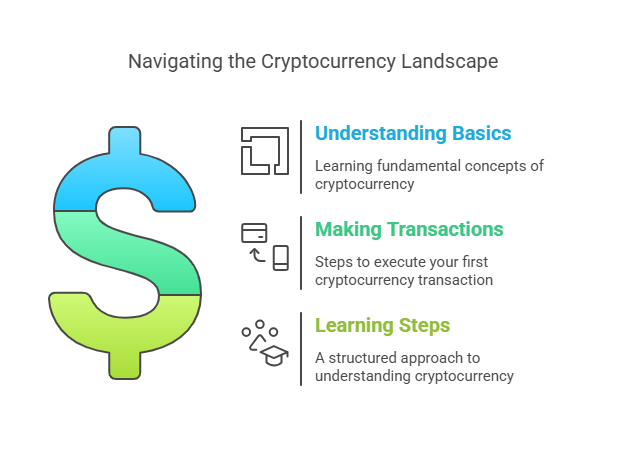
Cryptocurrency has come a long way from being a niche interest to a global financial phenomenon. With its increasing popularity, many people are looking to get involved in the world of crypto. However, for beginners, the concept of cryptocurrency can seem intimidating. From understanding the basics to making your first transaction, there’s a lot to learn. But don’t worry! This guide will walk you through the steps of getting started with crypto and help you navigate this exciting new financial landscape.
1. What is Cryptocurrency?
Before diving into how to get started with crypto, it’s important to understand what it is. Cryptocurrency is a type of digital or virtual currency that relies on cryptography for security. Unlike traditional currencies issued by governments (like dollars, euros, or yen), cryptocurrencies are decentralized and usually based on blockchain technology.
The most well-known cryptocurrency is Bitcoin, which was created in 2009 by an anonymous person or group known as Satoshi Nakamoto. Since then, thousands of other cryptocurrencies have been created, including Ethereum, Ripple (XRP), Litecoin, and many more.
Cryptocurrencies are not controlled by any central authority (like a government or a bank), making them attractive to those seeking a decentralized financial system. Transactions are recorded on the blockchain, which is a distributed ledger that is accessible to anyone but cannot be tampered with.
2. Why Should You Invest in Crypto?
There are a number of reasons why people are interested in investing in cryptocurrencies:
- Decentralization: Cryptocurrencies operate on decentralized networks, which means no single entity or government controls them. This offers an alternative to traditional banking systems and is appealing to those looking for more financial freedom.
- Potential for High Returns: Cryptocurrencies have shown the potential for significant price increases over a short period. Many early adopters of Bitcoin, for instance, saw substantial returns on their investments.
- Innovation: Blockchain technology, which underpins most cryptocurrencies, is seen as revolutionary. It has the potential to disrupt various industries, from finance and healthcare to supply chain management and voting systems.
- Privacy: Cryptocurrencies can offer a level of privacy that traditional currencies don’t. While transactions are recorded on the blockchain, they can be more anonymous than traditional banking.
However, it’s important to note that cryptocurrencies are still highly volatile and speculative. Prices can fluctuate dramatically, so it’s essential to be aware of the risks involved.
3. How to Buy Your First Cryptocurrency
Now that you understand the basics of crypto, let’s dive into the practical steps of buying your first cryptocurrency.
Step 1: Choose a Cryptocurrency Exchange
The first step in buying cryptocurrency is selecting a reliable exchange. A cryptocurrency exchange is a platform where you can buy, sell, and trade cryptocurrencies. Some of the most popular exchanges include:
- Coinbase: Known for its user-friendly interface, Coinbase is a great option for beginners.
- Binance: A popular exchange with a wide range of cryptocurrencies available for trading.
- Kraken: Another well-established exchange that offers a variety of crypto assets.
- Gemini: Known for its security and regulatory compliance.
When choosing an exchange, consider the following factors:
- Security: Look for an exchange with strong security features, such as two-factor authentication (2FA) and cold storage for the majority of its assets.
- Fees: Compare fees between exchanges, as they can vary significantly. Look for an exchange with low fees, especially if you plan on trading frequently.
- Supported Cryptocurrencies: Make sure the exchange supports the cryptocurrency you want to buy.
Step 2: Create an Account
Once you’ve chosen an exchange, you’ll need to create an account. This process typically involves providing your email address, creating a password, and verifying your identity by submitting a form of identification (like a driver’s license or passport).
Step 3: Deposit Funds
After your account is set up, you’ll need to deposit funds. Most exchanges allow you to fund your account using a bank transfer, credit/debit card, or even PayPal (depending on the exchange). If you’re planning to buy a large amount of crypto, bank transfers tend to have lower fees.
Step 4: Place Your First Order
Once your account is funded, you can place your first order. On most exchanges, you’ll have the option to buy cryptocurrency at the current market price or place a limit order (an order to buy at a specific price). If you’re a beginner, it’s usually easiest to buy at the current market price.
Step 5: Secure Your Cryptocurrency
After your purchase, you’ll want to store your cryptocurrency safely. While exchanges typically offer a wallet for storing your crypto, it’s a good idea to transfer your assets to a private wallet for added security.
There are two main types of crypto wallets:
- Hot Wallets: These are online wallets that are connected to the internet. They’re convenient for quick access but are more vulnerable to hacking.
- Cold Wallets: These are offline wallets that store your crypto on hardware devices, making them much more secure from online threats.
Popular cold wallets include the Ledger Nano S and Trezor, while hot wallets like MetaMask and Trust Wallet are commonly used for managing assets online.
4. Understanding Cryptocurrency Security
Security is a top concern when it comes to cryptocurrencies. Here are a few key tips to keep your crypto safe:
- Enable Two-Factor Authentication (2FA): This adds an extra layer of security by requiring a second form of identification (such as a code sent to your phone) when logging into your account.
- Use Strong Passwords: Use a complex, unique password for your exchange account and wallet. Consider using a password manager to securely store your passwords.
- Avoid Phishing Scams: Be cautious of emails or messages that claim to be from exchanges or wallet providers. Always verify the source before clicking on links or providing personal information.
- Backup Your Private Keys: If you’re using a cold wallet, make sure to keep your private keys (the codes that allow you to access your cryptocurrency) in a safe place.
5. How to Track and Manage Your Crypto Portfolio
Once you’ve bought cryptocurrency, it’s important to keep track of your investments. Several apps and websites can help you track your crypto portfolio:
- Blockfolio: This app allows you to track the prices of cryptocurrencies and manage your portfolio.
- Delta: Similar to Blockfolio, Delta provides real-time price tracking and portfolio management tools.
- CoinGecko: An online platform that offers up-to-date market data and portfolio tracking.
Many of these platforms also allow you to set price alerts, so you’ll be notified when your coins reach a certain value.
6. The Risks of Investing in Crypto
While the potential for high returns is one of the main attractions of cryptocurrency, it’s important to understand that crypto investments carry significant risks. These include:
- Volatility: Cryptocurrencies are highly volatile, and their prices can change dramatically in a short amount of time.
- Regulatory Risks: Governments around the world are still figuring out how to regulate cryptocurrencies. Changes in regulations could affect the value or legality of certain coins.
- Security Risks: If you don’t take proper precautions, your crypto could be stolen through hacks or phishing attacks.
It’s crucial to only invest what you can afford to lose and to take the necessary steps to secure your holdings.
Getting started with cryptocurrency can be a rewarding but complex journey. By following the steps outlined in this guide — from choosing an exchange to securing your assets — you’ll be well on your way to understanding the world of crypto. Remember to stay informed, take security seriously, and always be aware of the risks involved. With patience and caution, you can enjoy exploring this exciting new frontier in finance.













